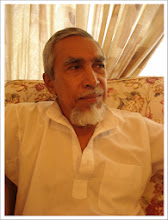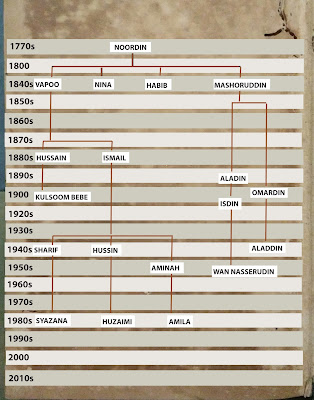1. As I have mentioned previously, I have no precise
dates of my father’s marriages. However, his first wife, Chik binti Hassan,
might have passed away sometime in June 1937 or earlier. In a letter dated 9
Rabi Al-Akhir, 1356 (=18 June, 1937) my father, administrator of Chik’s estate,
offered for sale land belonging to the deceased to the state government on
account of settling her estate. This was only a few months away before he
retired from the KCS on 23 September, 1937.
2. After Chik passed away, my father married
Che Chah, the widow of one Che Daim. They might have been married after his
retirement. As I have mentioned in one of my posts, Che Chah had a son named
Che Omar from her previous marriage. The latter got married to his cousin, Che
Tom who was a daughter of Zainuddin, Che Daim’s elder brother.
3. Previously, I wrote
that my father left Alor Star and
moved to Alor Merah after his second wife died of oedema in the middle of
1940s. This was incorrect because recently I was told that my grandmother (on
my mother’s side) used to visit the sick woman in the big wooden house where my
father resided after moving to Alor Merah. Somehow, my grandmother was related
to Che Chah’s side of the family.
4. It was related that Che Chah, apparently
realizing her illness was terminal, had wished for an arranged marriage of her
husband with any of her relatives; hence my parents’ marriage. My father might
have been very happy and proud to have the three of us from his third and last
marriage. He had no children from previous marriages.
5. I have to admit that I have a bad memory. My
childhood memory is dim and hazy. But I still remember the big wooden house by
the side of the main road where I spent part of my early childhood. Like any
traditional Malay house, the building was raised on tall pillars. A veranda
with a rather high staircase adorned the centre of the façade. I still remember
losing my balance while playing near the top of the staircase and went rolling
down the flight of stairs all the way to the bottom.
6. I have no knowledge whatsoever of the
history of the grand old house. As I recall, it might have been standing for at
least a generation at the time. The front door led to a spacious hall extending
the full width of the building. Rooms flanked both sides of the house with a
wide hallway between them.
7. We lived there amid a big family of my
father’s stepson and his wife, Che Tom. As I recall, they had at least eight
children aged between twenty and four, more or less, at that time. Che Omar’s
children referred to my father as “Tuk Wan” (grandpa) and they revered him very
much. The other members of the household include Che Tom’s single sister, a teenage
daughter of my father’s adopted son and a servant.
8. Che Omar came over every now and then; he was
working in a distant district and living with his second wife. My mother told
me later that it was my father who supported the whole household out of his
pension. Generosity was one of his notable traits. He would keep an envelope
full of coins handy and give away a coin or two to the children for treats or
pocket money.
9. We had a rather crowded room to ourselves.
It accommodated a large old-fashioned iron bed and a cupboard for our clothes.
My parents slept on the bed while the three of us slept on a piece of mattress
on the floor alongside the bed. Meals were served by a servant. My father took
his daily meals alone at regular times at a large table in the hallway. My
mother ate with us at a small table in front of our room.
10. Being so young at that time, I was not
aware until later that my mother was somehow not at all comfortable with the
situation that we were in. I still remember the time when she was looking
around for a house to move in; my grandmother took us to a vacant house to survey
its condition. The house was just across a small river opposite to her house,
but somehow nothing transpired.
11. My mother was quite thrifty, so she was able
to save her monthly allowance for several years after her marriage. She spent
her savings to build a house adjoining her mother’s house in the kampong. I was
still very young then about eight years old or so when the house was being
built by the village carpenter and his young son who made me a toy aeroplane
from pieces of woods. They would take several months to raise the building. I
knew then that we were moving in when the time came.
12. But it would not be a smooth transition. Apparently
tension had been rising between my mother and Che Tom’s side of the household that
I was not aware of at all. It might have caused a row to break out one night. I
have only a dim and hazy memory of what happened on that night of chaos and
confusion. The women were exchanging angry words with one another releasing
their feelings of discontent. There was an atmosphere of resentment and tension
at the veranda of the big house where it happened. I remember my grandmother
was there for her daughter. That is all I remember; everything else is dim to
me.
13. The consequence of the episode was, of course,
moving to my grandmother’s place. My ailing father was accommodated with a room
to himself. None of his belongings which include a treasure trove of books were
left behind. He stayed for a few months at his in-law’s house before breathing
his last. His body was carried to the new house where the funeral rituals were
initiated. He was laid to rest at the local cemetery in Alor Merah.
 |
| A cutting from the Straits Echo dated 26 November, 1956 |
KCS = Kedah Government
Service












